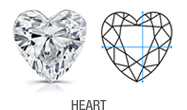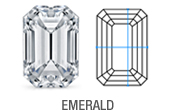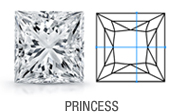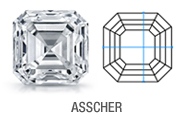- Home
- Education
CARAT
Carat
Weighing diamonds and a variety of other gemstones are done in metric carats: 1 carat is the equivalent of 0.2 grams, the weight is the same as a paperclip. (Don’t mix up carat with karat, as in “18K gold,” which is referring to gold purity.)

One carat is divided into 100 points just as a dollar is divided into 100 pennies. For example, the weight of a 50-point diamond is 0.50 carats. On the other hand, two diamonds with equal weight can have values that are very different based on the other members of the Four C’s: cut, color, and clarity. The weight of most diamonds used in fine jewelry is a carat or less.
Because even a fragment of a carat can make a huge difference in price, precision is crucial. Weight is often measured to the hundred thousandths of a carat and rounded to a hundredth of a carat in the diamond industry. The weight of diamonds greater than one carat is expressed in decimals and carats. (For example, a 1.08 ct. stone would be described as “one oh eight” or “one point oh eight carats,”)
HOW DID THE CARAT SYSTEM START?
The carat is the diamond and various other gemstones standard unit of weight and its name was taken from the carob seed. Since these tiny seeds had a fairly uniform weight, early gem traders used them in their balance scales as counterweights. The modern metric carat, equal to 0.2 grams, was adopted by the United States in 1913 and other countries soon after. Nowadays, the weight of one carat is exactly the same everywhere in the world.
COLOR
Color
The color of diamonds is about what you cannot see. The value of diamonds is determined based on how they closely come near colorlessness – they are higher value with less color. (The color pink and blue, which lie outside this color range is the exception to this fancy-color diamond).

The majority of diamonds in jewelry stores run to near-colorless from colorless, with small hints of brown or yellow.
It is the industry standard for GIA’s color-grading scale for diamonds The scale starts with the letter D, representing colorless, and continues with increasing presence of color to the letter Z, or near-colorless. Each letter grade has a clearly defined range of color appearance. Diamonds are color-graded by comparing them to stones of known color under controlled lighting and precise viewing conditions.
Most of these color differences are hard to see with the untrained eye. However, these small differences make a very big difference in diamond price and quality.

WHY DOES THE GIA COLOR GRADING SYSTEM START AT D?
Prior to GIA developed the D-Z Color Grading Scale, various other systems were applied loosely which included letters of the alphabet (A, B, and C, with multiple A’s for the best stones), Arabic (0, 1, 2, 3) and Roman (I, II, III) numerals, and descriptions such as “gem blue” or “blue white.” The outcome of all these grading systems was inaccuracy and inconsistency. Since the creators of the GIA Color Scale wanted a fresh start, with no connection with previous systems, they opted to begin with the letter D—a letter grade normally not linked with top quality.
CLARITY

Clarity

Due to the fact that diamonds are naturally created deep inside our planet, under intense pressure and heat, they often have birthmarks so unique, either external (blemishes) or internal (inclusions).
Diamond clarity is referring to the absence of these blemishes and inclusions. It’s rare to find diamonds with no birthmarks, and the diamond’s value is affected due to its rarity. Diamonds are given a clarity grade that ranges from flawless (FL) to diamonds with obvious inclusions (I3) using the GIA International Diamond Grading System™.
All diamonds are unique. None is absolutely perfect under 10× magnification, though some come close. They are called Flawless diamonds, and these are very rare. Many jewelers never even set their sights on one.
The GIA Clarity Scale consists of 11 grades, with several diamonds categorized into the (slightly included) or VS (very slightly included). When it comes to deciding a clarity grade, the GIA system considers the color, position, nature, relief or size, and amount of clarity characteristics visible under 10× magnification.
Flawless (FL) - No inclusions or blemishes are visible to a skilled grader using 10× magnification
Internally Flawless (IF) - No inclusions and only blemishes are visible to a skilled grader using 10× magnification
Very, Very Slightly Included (VVS1 and VVS2) - Inclusions are difficult for a skilled grader to see under 10× magnification
Slightly Included (SI1 and SI2) - Inclusions are noticeable to a skilled grader using 10× magnification
Included (I1, I2, and I3) - Inclusions are clear under 10× magnification and might affect brilliance and transparency
HOW DID THE GIA CLARITY SCALE COME ABOUT?
Same as the color scale, GIA’s clarity grading system developed since jewelers were utilizing easily misinterpreted terms, like "piqué" or "loupe clean." These days, despite you purchasing diamonds in other countries, the jeweler would definitely utilize terms like SI2 or VVS1, even though their language is Japanese or French rather than English.
CUT
Cut
Cut is the component that ignites a diamond’s sparkle, brilliance, and fire.
The traditional 58 facets in a round brilliant diamond, each defined and cut precisely, are as small as two millimeters in diameter. A diamond wouldn’t be nearly as beautiful without this precision. The allure of a particular diamond depends more on cut than anything else.
Though extremely difficult to analyze or quantify, the cut of any diamond has three attributes: brilliance (the total light reflected from a diamond), fire (the dispersion of light into the colors of the spectrum), and scintillation (when a diamond is moved, it creates a sparkle or flashes of light).
An understanding of diamond cut starts with the diamond’s shape. The shape that is a standard round brilliant is used in majority of the diamond jewelry. Most others are well-known as fancy shapes. Traditional fancy shapes are inclusive of the oval, pear, and emerald cuts. Triangle, cushions, hearts, and various others are also becoming more popular in diamond jewelry.

As a value factor, though, cut refers to a diamond’s polish, symmetry, and proportions. For instance, observe a side view of the standard round brilliant. The main components, from top to bottom, are the pavilion, girdle, and crown. A round brilliant cut diamond has 57 or 58 facets, the 58th being a small and flat facet at the bottom of the pavilion that is called the culet. The huge, flat facet on the top is the table. The diamonds proportion refers to the relationships between pavilion depth, table size, and crown angle. A wide range of proportion combinations are possible, and eventually, these affect the interaction between the stone and light.
GIA revealed a diamond cut grading system for standard round brilliants in the color range of D-to-Z in early 2005. A system, and product of over 15 years of thorough testing and research, places an overall diamond cut grade between Poor and Excellent.
HOW DOES PAVILION DEPTH AFFECT A DIAMOND'S CUT?
The pavilion depth is the length between the bottom of the girdle and the culet. A pavilion depth that’s too deep or too shallow enables light to escape through the bottom or the sides of the stone. A diamond that’s well-cut will direct more light through the crown.
SHAPE
Shape
The shape that most people will be familiar with is the round diamond. This represents the classic diamond, the example of brilliance and shine. However, there are actually several other shapes in addition to the standard round. To flawlessly cut these various shapes, It takes a precise and careful hand. Below, you will find examples of the different shapes that you might find in our store.










